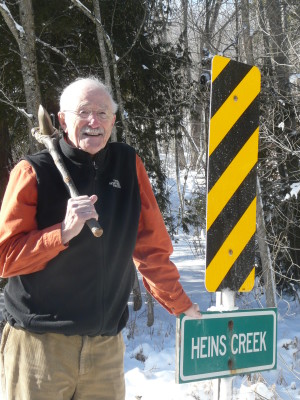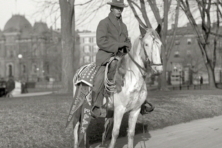- Door County
- Parks
- Nature
- History
- Baileys Harbor
- Outdoor
- Indoor Activities
- Jacksonport
- Southern Door
- Sturgeon Bay
- Washington Island
- Rock Island
Celebrate Native American Heritage Month
- Share
- Tweet
- Pin
- Share

Hanging above a desk at the Door County Land Trust is a bumper sticker that reads “Great Minds Think A Hike.” In 1990, by presidential decree, November was declared Native American Heritage Month and taking a hike is a fitting way to note and appreciate an important, less visible and often forgotten chapter in Door County history.
Paul Burton, in More Door County Stories … and the Indians who discovered the Door Peninsula, says that when we talk about Door County history and the “old times,” we’re generally not looking back far enough. He states, “The ‘old days’ to us are just a drop in the ocean of human history that tells the story of the Door Peninsula.”
Thanks to archeological digs held on Washington and Rock Islands, at North Bay, Heins Creek, Whitefish Bay, in Sturgeon Bay and Southern Door and elsewhere, there is plentiful evidence of a Native American presence throughout Door County. Artifacts point to Oneota (1200 – 1400 AD) Mississippian (400 to 1300 AD) Woodland (1000 BC to 1300 AD) and Archaic (8000 – 1000 BC) settlements and a dig in 2003 at the Cardy property in Sturgeon Bay (see below) even established Paleoindian presence as many as 8,000 – 11,000 years ago.
A great place to hike and imagine the rows of wigwams that once dotted the lands near the Lake Michigan shoreline is at the Door County Land Trust’s Heins Creek Nature Preserve located midway between Jacksonport and Baileys Harbor on the east side of Highway 57. It’s estimated that as many as 1,000 Native Americans may have had seasonal settlements in the Heins and Hibbard Creek areas during the Woodland era. They would have been drawn here by the abundance of lake sturgeon, walleyes, trout and whitefish. The nature preserve has off-road parking and a looped, marked trail that will take you along the creek, through a hardwood forest and over an impressive dune area.

Local historian and author Paul Burton poses at the Heins Creek Nature Preserve with a stone ax representative of the Native American culture that resided along Heins Creek during the Late Woodland Period. Photo by Cinnamon Rossman.
A bit further south along Lake Michigan is Whitefish Dunes State Park, the site of archeological digs in 1986 and 1992. A display in the Nature Center and a pamphlet available at the desk describe how various Native American peoples used the area during eight distinct time periods over the dunes’ 3,000-year existence. The 13-minute People of the Dunes video is well worth seeing before you head outdoors. A wooded trail takes you past recreated structures of the North Bay, Late Woodland and Oneota Peoples. Fish and net-drying racks are visible as well as simple huts. A brisk return walk along the beach is invigorating and a good reminder of why most Native Americans established winter camps on the more protected Green Bay side of the Door Peninsula.
Another site of interest is the Cardy Paleoindian Campsite on the west side of Sturgeon Bay, just across Spruce Street from Forbes Funeral Home. The inconspicuous field belies the importance of the discovery made here. A kiosk describes the 2003 dig led by archeologist Dr. David Overstreet that uncovered artifacts showing Paleoindian presence. Paleoindians were ancestors to contemporary Native Americans. They were hunters and gatherers who followed large game such as mammoths and mastodons. Prior to the dig, scientists believed that glaciers covered the Door Peninsula during the last ice age. They now believe that the Door Peninsula may have been on the glacier’s edge, a place where glacial lakes formed and hunters had access to the animals attracted to them.
If you’re looking for a warmer, indoor way to embrace Native American history, stoke the fire and curl up with Burton’s engaging More Door County Stories … and the Indians who discovered the Door Peninsula (Stonehill Publishing, Ephraim, Wisconsin 2009). He gives a compelling account of how Native Americans lived in Door County—what they ate, how they hunted, what they wore. He also shares some of the surviving stories—like the Legend of Death’s Door—that will not only make your fire feel that much warmer, they will also make the peninsula much more interesting when you do venture out.
In Burton’s words, “Indians lived, hunted, gave birth and died along the shore or in the forests of Door County long before Europeans began to dream about riches to be found in faraway lands.” Happy Native American Heritage Month.




